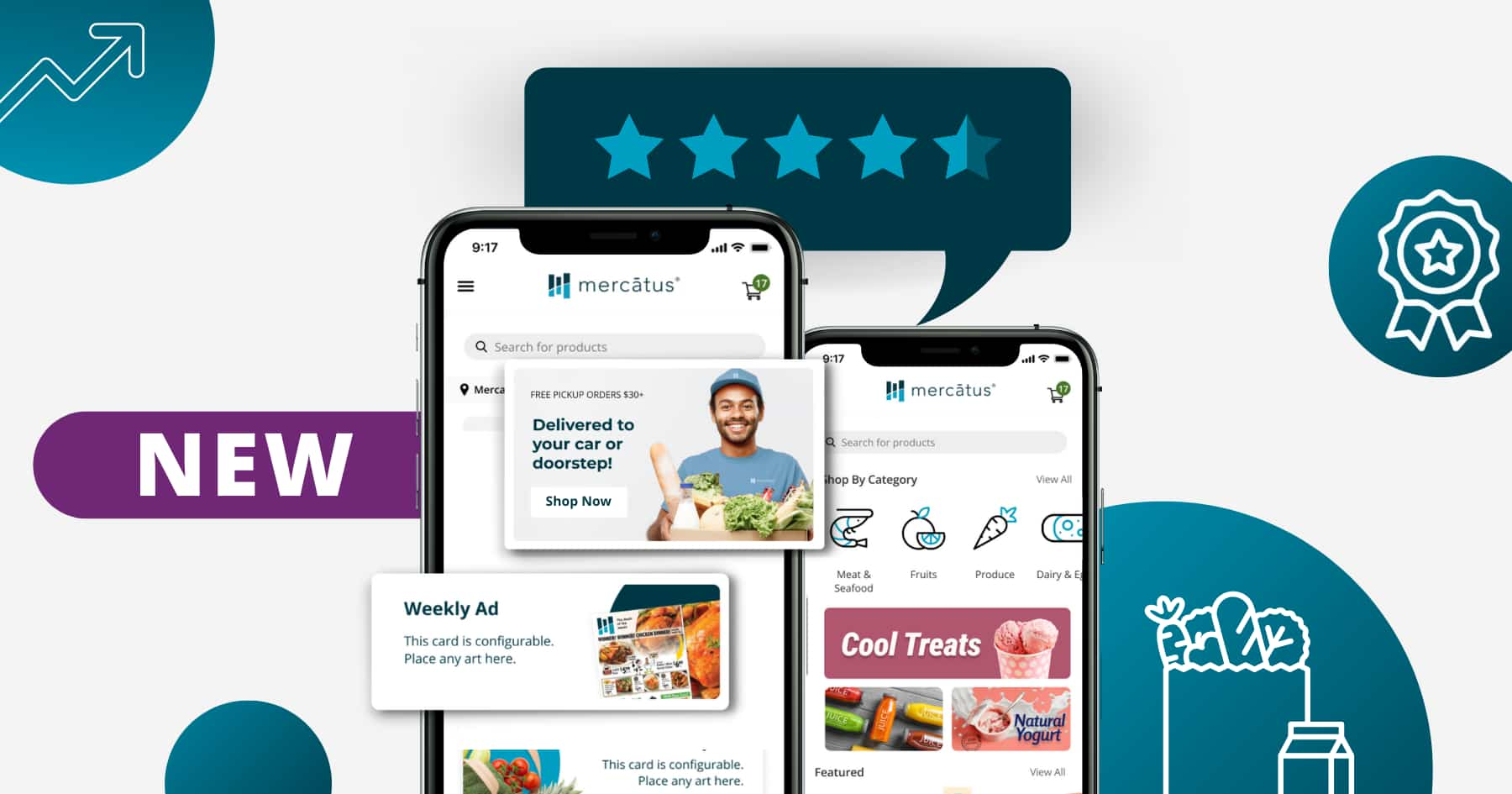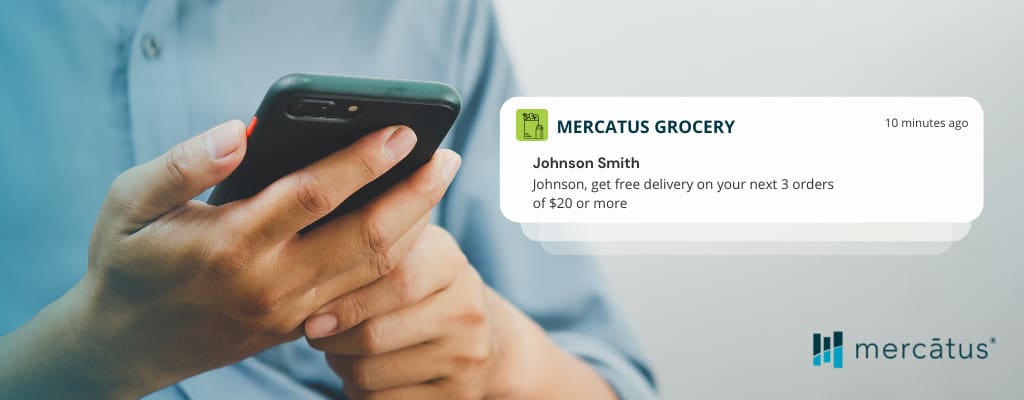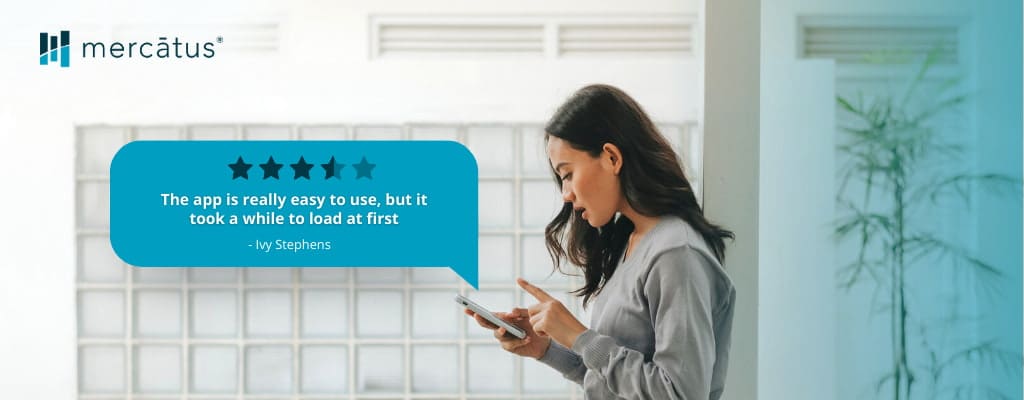
Mobile Grocery App Launch: The 11-Step Guide
For regional grocers looking to compete with mass merchants by operating their own eCommerce experience, investing in a solution that’s convenient for your customers is critical. Today’s omnichannel shoppers love the convenience of shopping online and they have specific expectations. They’re looking for a mobile grocery app that is functional, easy-to-use, and smoothly translates the in-store experience online.
If your existing mobile app is failing to meet shoppers’ expectations, it may be time to consider launching with a brand new solution. Luckily, by combining the right technology with a savvy communications strategy and cross-channel operational excellence, grocers can now launch mobile apps easier than ever before.
Read on to uncover the comprehensive 11-step guide to launching (or relaunching) a mobile grocery app.
Mobile Grocery Shopping: The Future of Grocery eCommerce
Mercatus recently conducted a survey of 2,000 U.S. consumers to better understand their habits and preferences with respect to grocery shopping. Here were some of our findings.
40% of U.S. Consumers Use Pickup or Delivery Monthly
Grocery pickup and delivery services are redefining the retail sector. In fact, 40% of US consumers are using these services monthly. No more long lines, no more crowded stores. That’s why retailers are stepping up with more online solutions, giving consumers the freedom to shop from home. This shift is changing the game for both shoppers and retailers.
Pickup is the Preferred Method of Online Grocery Shopping
Though delivery was a popular choice in the peak of the pandemic, pickup is proving itself to be the preferred solution as consumers return to pre-pandemic shopping patterns. According to our study, 31% of U.S. households had used a pickup service within the last month, and nearly 50% within the last year.
Customers Rely on Mobile Apps to Complete Grocery Pickups
Among online grocery shoppers that use pickup services, 71% received their order delivered to their car and 48% of those customers notified the store of their arrival via the retailer’s mobile app. That tells us that not only are retailers embracing mobile technologies, but that shoppers are keen to adopt these platforms.
“When it comes to Pickup, linking order staging readiness with geolocation notifications triggered automatically by the retailer’s branded mobile app is an effective way to streamline the Pickup experience into a faster, hassle-free experience. Shorter wait times at Pickup can have a dramatic effect on customer perception and brand affinity and will go a long way to encouraging repeat customer behavior. ” - Sylvain Perrier, President and CEO, Mercatus.
The 11-Steps to Launching a New Grocery eCommerce Mobile App
So you probably get it—online grocery shopping isn’t going away. Grocery shoppers are getting more and more comfortable with the convenience of placing grocery orders from the comfort of their mobile devices. That’s why grocery retailers need to ensure that they are making it easy for those mobile app transactions to occur.
Whether you’re a grocery retailer with an existing mobile app that’s going out of style or you’re looking to pioneer your first-ever mobile eCommerce platform—you’re going to need a plan of attack. Follow these 11 steps to ensure that your implementation is successful.
Pre-Launch Activities
Pre-launch activities set the stage for a killer app launch. From creating buzz to refining the user experience and everything in between, these steps are crucial to success. In this section, we'll guide you through the musts for a successful grocery eCommerce mobile app launch. Get ready to learn and launch with confidence!
1. Contact Your Existing eCommerce Platform Provider
If you’re migrating from one eCommerce platform to another, it’s important that you inform your existing provider that you’re migrating well ahead of time to ensure the success of your launch. Most providers will cooperate with your migration process and export essential data such as your customer database and content files. In addition to these files, you’ll need to make sure you get access to your app’s Apple Developer Account (iOS) and Keystore (Android) if you don’t already have it. Your new provider will be able to provide a full migration checklist so make sure you speak to their technical team to get a head start on collecting all the necessary information.
If your existing provider is slow to support or even blocks you from doing so, you may need to release a new app on the Apple Store or Google Play. If this is the route you have to pursue, it’s critical that you plan a robust marketing campaign (see more on this topic in Step five - Build a Communications Strategy) and leverage in-app notifications in the existing app to notify customers about the transition process as they will have to find and download the new app.
2. Know Your Target Audience
It is essential that regional grocery stores understand the shopping habits of their consumers so that they can tailor the mobile experience to meet (and exceed) their needs. The best way to understand your audience is by analyzing both first and third-party data.
First-party data is any information that you have on your customer base, be it:
- Customer name and contact information (email, phone number)
- Purchase history and buying patterns
- Loyalty program information and rewards
- Demographic information (age, gender, income, location)
- Feedback and surveys responses
Third-party grocery data can be sourced from industry associations or research firms like Brick Meets Click that help grocers make more informed strategic decisions. For example, the monthly Brick Meets Click/Mercatus Grocery Shopping Survey collects deeper insights than what might be available to most grocers, and serves as a waypoint or guide on topics such as:
- Providing a more complete picture of eGrocery trends
- Focusing on key business questions for grocery retailers
- Examining household behaviors of primary grocery purchaser
- Analyzing grocery spending, both instore and online
- Measures online buying behaviors, like purchase recency, order frequency, formats shopped, and dollars spent
- Monitoring the most recent experiences, like format shopped, amount spent, method used to receive order, past-usage history, and measures of satisfaction.
Use a combination of first and third-party data to determine what features your customers are looking for in a mobile app so that you can build a delightful online shopping experience.
3. Define Your App’s Value
If you are making the decision to transition to a new mobile grocery app or replace an existing one, then you need to be able to clearly articulate the answer to these four questions:
1. Where does your existing mobile app fail to meet customer needs?
When it comes to grocery apps, it’s critical that yours delivers exceptional value in 4 areas: seamless shopping, personalization, rewards & loyalty, and feature innovation.
Seamless shopping should be at the core of every app. From cart building to the checkout process, the app experience should be as frictionless as possible. Personalization is how well the content in the app reflects the preferences and interests of the individual customer. Great grocery apps should be focused on serving product recommendations, search functionality, and shopper profiling.
Part and parcel with personalization is rewards & loyalty. Offering a robust loyalty program encourages app adoption and will help increase share of wallet. And finally, feature innovation is how often you’re releasing new upgrades to improve the customer experience. The underlying architecture of your app should make it easy to develop new features to stay ahead of the competition.
2. What features and functionalities will you upgrade with the new app?
Based on your assessment of the first question, you’ll be in a good position to determine where your app experience can be improved. Are there improvements you’d like to make say with the cart building or checkout process? Is personalization an area that you’d like to improve? Will you be re-introducing your loyalty program as part of your launch? Or are there net new features your customers have been consistently requesting?
The important part here is that the product development team has a clear roadmap and prioritization of the features that will deliver the greatest value for the business and your customers.
3. What benefits does the new app offer your business?
From a business standpoint, the overarching goal for your mobile app should be to help drive brand affinity and customer lifetime value as we know that omnichannel shoppers spend more with your brand than single-channel shoppers. Increased average order value (AOV), more frequent repeat purchases, and an overall increase in share of wallet and mobile channel revenue are a few benefits - among others - an improved app experience should bring to your business.
4. What benefits does the new app offer your customers?
Grocery shopping has become an “always-on” experience. Customers might start a basket on Wednesday morning, adding items as they might to a running shopping list, placing their order on Friday night, and schedule pickup on Saturday afternoon. Every step of the way, the app experience should be making it easy for customers to build their baskets, discover relevant products, and checkout with a pickup or delivery option that’s most convenient to them.
4. Optimize Your App for Engagement, Conversion, & Retention
If you are replacing your existing app or mobile shopping experience, then your objective should be to improve in-app engagement, conversion rates, and customer retention.
Use these tactics to optimize your mobile grocery app for engagement, conversion, and retention:
- Stellar design. Make your app visually stunning and easy to navigate.
- Deep personalization. Offer customized recommendations and deals based on shopping behavior.
- Listen to the masses. Encourage user feedback and respond to their wants and needs.
- Lightning-fast checkouts. Make checkout fast and secure, with multiple payment options.
- Inventory updates. Minimize substitutions by keeping inventory data fresh.
- Incentivize repeat purchasing. Offer rewards, discounts, and loyalty programs for repeat purchases.
- Notify with purpose. Use push notifications for new arrivals, sales, and promotions.
Take your mobile grocery app to the next level with these tactics and watch your engagement, conversions, and retention climb.
5. Build a Communications Strategy
As you prepare for the launch of your mobile grocery app, there is a lot of work to be done to ensure that your audience is aware of the new platform.
- Segment your target audience based on demographics or behaviors. Identify the age, gender, location, and interests of various subsets of your target audience, as well as their shopping habits so that you can hyper-target your campaigns.
- Determine launch campaign objectives. What are the goals of your communication strategy? Are you aiming to drive app downloads, increase brand awareness, attract new customers, or otherwise?
- Choose your promotional channels. Some of the best channels to use to promote your eGrocery app are in-store signage, both the print and digital versions of your flyer, grocery bag tip-ins, outdoor signage (in the parking lot, at the entrance) push notifications (if you have an existing app), email communications, website content, and more. Your strategy for social channels should include organic and paid, but also user generated content with influencers within your target audience.
- Develop messaging. Craft a clear and concise message that highlights the key features and benefits of your app. Be sure to emphasize how seamless the transition will be from the old app and shopping experience to the new one.
- Create content. Develop engaging graphics, banners, videos, tutorials, and product demos that showcase your app and its unique selling points.
As mentioned in Step one, if your current eCommerce platform provider is making it difficult to migrate your existing app, you will need to adjust your communications strategy to address this change. For your customers, the transition from one app to another needs to be as seamless as possible. You will need to develop messaging around new key features and the benefits they will provide over the previous app. Finally, you will need to get your messaging across through the appropriate channels, such as push notifications on the previous app informing customers about the new one.
6. Define Metrics to Measure Success
Once you’ve completed your comms strategy, you will need to create a list of KPIs that will help you measure the success of your app launch.
The most important metrics to monitor include:
- User acquisition:
- The number of download
- Sources of traffic
- Installs
- User engagement:
- DAU (daily active users)
- WAU (weekly active users)
- MAU (monthly active users)
- Session length
- Retention rate
- Revenue generated:
- Cart conversions
- Average order value
- Retail media revenue
- User Feedback. Reviews, ratings, and customer surveys.
- Performance. App crashes and usability issues.
- Technical Issues. Server response time, API errors, payment failures.
Read our in-depth article on grocery retail KPIs to learn more about the top KPIs that grocers need to be monitoring.
Note for grocers with an existing mobile app: Grocers that are replacing an existing mobile app need to keep an especially close eye on their DAU, WAU, and MAU on both the old app and the new app. The percentage of users that make the migration is a leading indicator of the success of your new app launch. Specific migration rates can vary largely depending on the type of app, the user base, the reasons for migration, the quality of the new app, and the transition process—generally resulting in a migration rate of anywhere from 20% to 70%. Since grocery apps are indispensable for customers and are typically used on a weekly cadence to coincide with the weekly grocery visit, it’s critical that DAU and WAU are tracked carefully.
It’s also important to establish feedback loops so that data on mobile app performance can easily be collected, analyzed, and used to inform your ongoing promotional strategy, development roadmap, and more.
Mercatus Console makes it easy to aggregate performance data on your mobile app at a store level or across a number of locations. And if you’re looking to mine insights from your data, Mercatus’s dedicated customer experience team is here to help. Explore Mercatus Mobile today to learn more about the leading native mobile grocery app in the industry.
During Launch Activities (Month 1)
Ready for lift-off? This section covers the must-dos during the launch of your mobile grocery app. From launching your marketing strategy to collecting customer feedback, these steps will help you ensure a successful launch.
7. Launch Your Communication Strategy
It’s time to flip the switch on all of the programs that you mapped out in the pre-launch phase of your journey. Some of these programs will require more active management, while others will require less effort, but It’s important to review the campaign and identify the best performing channels and messaging. Having the capacity to redirect funds and update upcoming channel communications with the messaging that is resonating with the audience will increase conversion.

8. Incentivize Customers to Use the New App
Some customers will be more inclined to adopt your new mobile grocery app, while others may be more hesitant. It’s important to note that there are many incentives for why a customer would consider trying a new or different mobile grocery app or service. However, not all those incentives are ones that retailers can use to persuade customers to try their app or service.
Our research on grocery pickup and delivery adoption determined that some of the most effective incentives that grocers can implement include $20 off the first order of $75 or more, or paying no fee for your first three orders. While the first promotion will persuade a potential customer to consider making a single order, the other will encourage them to try out the app at least three times. According to research conducted by Brick Meets Click, the likelihood of a customer reusing a service increases with every use, after four times the rate is approximately 85%.
During the launch of your app, consider encouraging potential shoppers to repeatedly use your pickup or delivery services through incentives that stretch for multiple orders. If successful, customers are highly likely to keep coming back to the app, adopting it into their lifestyle. Consider using the following controllable tactics to boost the adoption of your new mobile app.
9. Collect Customer Feedback
“The customer is always right.” The old adage is especially true when it comes to app development. Collecting early feedback allows you to be adaptive and responsive in the first month of the launch, but you should continue to actively encourage and collect feedback through at least the first six months after app launch.
Mercatus Mobile comes with a built-in feature to help grocers collect and monitor app feedback. It’s called Integrated Voice of the Customer, and here’s how it works:
- After a new user submits an order, they will be asked if they love the {insert company} app.
- If the new user selects “Yes,” they will be prompted to leave a rating and a review which will automatically be linked to either the App Store or Google Play Store.
- If the user chooses “No,” they will be provided with a feedback form so that they can offer more details.
This feature is invaluable to grocers for two reasons. Firstly, it allows you to quickly and easily collect customer feedback that can be used to make timely app revisions. Secondly, it makes it almost effortless for your loyal fans to leave rave reviews and positive ratings for your app.
One Mercatus client has been able to grow their review volumes significantly on Android and iOS while also maintaining a 4.8+ star rating on both platforms. That’s the power of Integrated Voice of the Customer.
Post-Launch Activities (Month 2 and Beyond)
Post-launch is make or break for your grocery eCommerce app. Monitor performance, gather user feedback, update, and promote to drive adoption and revenue. This section covers the key post-launch activities to ensure ongoing success.
10. Retain Users & Expand App Usage
Once your mobile grocery app is live, it’s time to focus on retention and expansion. Our data shows that the first 15 days after the initial mobile eCommerce sale are mission-critical in determining customer retention. If you can drive a second purchase within that period, retention rates climb dramatically.
The following tactics can improve user retention rates:
- Seamless onboarding. Streamline the sign-up and onboarding process to make it quick and user-friendly.
- Personalization. Offer a personalized product search experience based on each user’s shopping history.
- Incentives. Offer incentives such as discounts or loyalty points to encourage users to keep coming back.
- User engagement. Use push notifications, email marketing, and other forms of communication to keep users engaged and informed about new products and deals.
Okay—you’ve successfully made yourself a swath of loyal customers. Now it’s time to start thinking about how you can expand the revenue from mobile accounts while also reducing your fulfillment costs.
The following tactics can help you expand mobile grocery revenue:
- Retail Media. Sell product placements to customers to help offset the costs of your mobile grocery program.
- Cross-selling and upselling. Suggest complementary or higher-priced products to customers during the checkout process.
- Private-label products. Promote your private-label products with higher margins and lower price points to attract cost-conscious consumers.
- Customer loyalty programs. Loyalty programs benefit customers, but they also help retailers as they encourage the formation of repeat and regular purchase patterns. In fact, 86% of US respondents said a loyalty program motivates them to buy again from a brand.
11. Monitor Feedback and KPIs
The final step in ensuring the long-term success of your new mobile grocery platform is keeping a keen eye on the KPIs identified in step six as well as all inbound customer feedback. Dips in usage rates and other key mobile app metrics can be powerful predictors of future shopping behavior and reviews can yield insights that can help you make adjustments and improvements to the mobile shopping experience.

Retailers must continuously keep up with KPI monitoring and customer feedback, in order to meet the evolving demands of the omnichannel shoppers. This includes integrating promotions and communications across in-store and online with long term marketing programs. Partnering with the right tech providers will ensure that your app is constantly receiving innovative updates, improving the overall user experience for your customers.
Mercatus Mobile: The Leading Mobile Grocery App for Retailers
Mercatus Mobile is the leading native mobile grocery app for grocers that want to foster a seamless white-label mobile shopping experience.
Mercatus Mobile gives users the power to increase average order values, increase order frequency, and deepen customer loyalty through a sophisticated, but easy-to-use interface.
New features in our next-gen mobile format include:
- Redesigned coupons. Use advanced behavioral data to serve customers with digital coupons at exactly the right time to increase savings, increase basket size, and foster deeper brand affinity.
- Interactive flyers. Mobile flyers have never been so fun. Provide a more engaging online experience and drive more sales with interactive flyers, built on the Flipp SDK.
- Digital loyalty cards. Put loyalty front and center by giving app users access to their digital loyalty card right from the navigation bar.

If you’re ready to deliver your customers the next-generation mobile shopping experience that they deserve, then contact us to schedule a tour with one of our product experts.
 Newsroom
Newsroom
